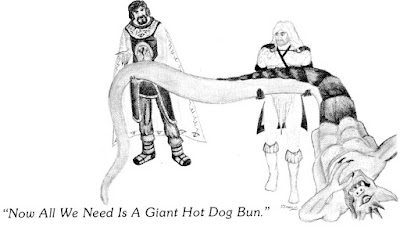 |
|
Luca Giordano The
Fall of the Rebel Angels (detail) 1660 - 1665
|
On page 76 of the DragonRaid Adventure Master Manual, there is an advice section named “When Players Try to Leave the Written Narrative.” It explains that other role-playing games permit (or even encourage) players to deviate from a scripted adventure. For DragonRaid, however, departing from structured adventure material is less than optimal. One must remember that, first and foremost, DragonRaid is supposed to be used for “imparting Christian truth.” Thus, “a departure from the text may cause players to miss out on valuable spiritual lessons.” Should this happen, “DragonRaid may become just another game – fun, but without educational value” (or rather the intended educational value).
So, how should an Adventure Master 'shepherd' the players when they start to stray from the course of the adventure? What would Gary do? According to The Keep on the Borderlands : “If a party attempts to move off the map, have a sign, a wandering stranger, a friendly talking magpie, or some other 'helper' tell them they are moving in the wrong direction.” Dick Wulf (designer of DragonRaid) encourages Adventure Masters to be “innovative” with regard to bringing the party back in-line with the adventure. As an example, “Tell the players that a talking magpie flies down in front of them and advises them that what they are about to do isn't in the OverLord's will!” I don't know about you, but a magpie is not going to deter me from my intended course of action. (O.K., a magpie might influence me, but it won't deter my character.) I am generally suspicious of the motives of magpies. In fact, if a magpie didn't want me to do something, I would be more inclined to do it. What would discourage me? A unicorn.
The “Celestial Guardians” section of the LightRaider Handbook (p. 56) states, “Both unicorns and pegasi are embodiments of angels in the world of EdenAgain.” Sometimes they take other forms. About a page is taken up with the “What we know about angels” section. Twenty 'facts' about angels are listed, such as, “They can eat food. (Genesis 18:8)” Each fact has a biblical citation except for one: “They are personal spirits possessing intelligence, wisdom, patience, meekness, modesty, holiness, obedience, knowledge, will power, and the ability to speak languages.” Anyway, why not just call an angel an angel? Why equate them with unicorns and pegasi? For that matter, why not just refer to the OverLord as Jesus?
Wulf employs allegory for a reason. On page 50 of the Adventure Master Manual, he explains that allegory is necessary...
...because sometimes people have heard things about Jesus Christ (or about Christianity) to which they have developed very definite responses, both positive and negative. These learned responses may block any further input. By using an allegory to retell those spiritual truths, the game provides a comfortable and non-threatening learning experience.Still, 'OverLord' sounds somewhat forbidding. I am reminded of the main antagonist in Blackstar (which aired prior to the publication of DragonRaid). Instead of OverLord, I would have gone with WorldLight.
It is important that the Adventure Master maintain the integrity of the allegory by rarely allowing players to say Jesus Christ or Lord instead of OverLord. It is too easy to be inconsistent and have the game lose its impact. The wonderful world of EdenAgain and all of its marvelous creatures may give way to “churchy” words like salvation, which repel or bore some people. Creativity and imagination are stifled, and as the game falters, God-given opportunities for teaching are lost.









